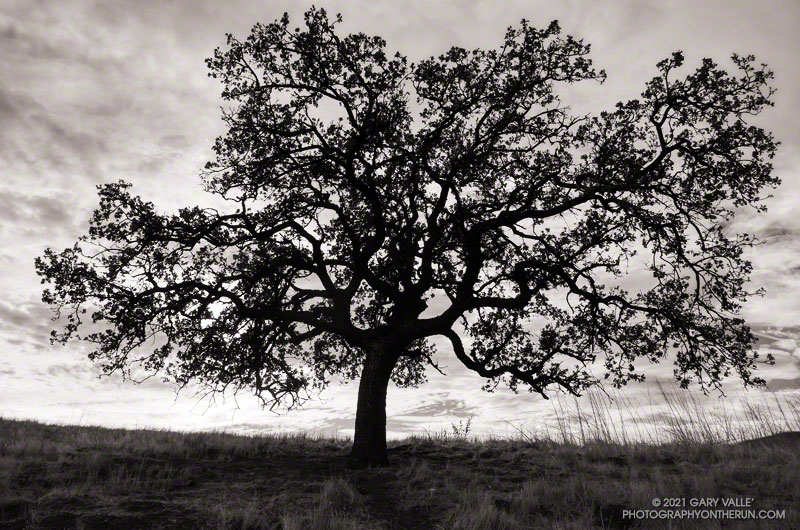
From a late afternoon run in Upper Las Virgenes Open Space Preserve (Ahmanson Ranch).
Some related posts: Guardian Oaks, Fallen Oak, Ahmanson Valley Oaks Battling Drought, After the Woolsey Fire: Ahmanson Ranch

From a late afternoon run in Upper Las Virgenes Open Space Preserve (Ahmanson Ranch).
Some related posts: Guardian Oaks, Fallen Oak, Ahmanson Valley Oaks Battling Drought, After the Woolsey Fire: Ahmanson Ranch
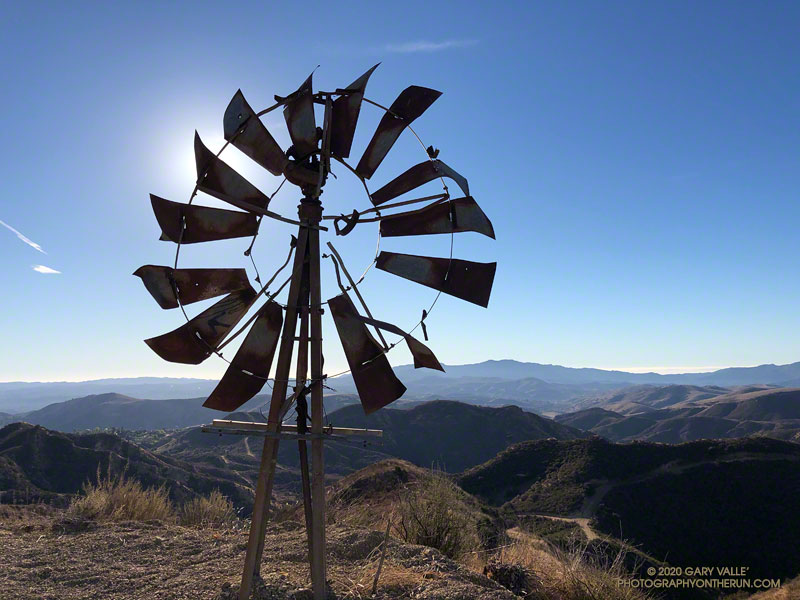
From the top of the hill, the blue-sky view extended all the way to Saddle Peak and the Pacific. The gray-green chaparral was brittle and dry, and the grasslands sun-bleached. Rain was in the forecast, but for months, little had fallen. It was the day after Christmas, and I was near the northern border of Upper Las Virgenes Canyon Open Space Preserve. Fourteen years ago, nearly to the day, I had run to the same hill. That rain year had also been dry, and the area had looked much the same.
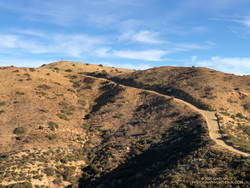
Today’s run had started at dawn at the Victory Trailhead. It had been cold in the canyons for the first few miles — in the low 30s — but eventually temps had warmed. I had run west in East Las Virgenes Canyon, taken a connector trail to Las Virgenes Canyon, and then run north on the Upper Las Virgenes Canyon fire road past Bell Canyon to “windmill hill.”
The hill is labeled with an elevation of 2124′ on the 1967 Calabasas topo map. The top of an old windmill has been placed on its summit. The windmill wasn’t there in 2006, and I wondered if it was from the infamous Runkle Canyon well. From the top of windmill hill I could see the high point of Upper Las Virgenes Canyon Open Space Preserve, a quarter-mile or so to the northeast.
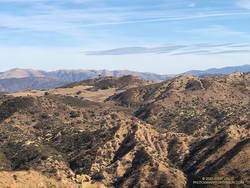
Located at its northeastern corner, the point with the highest elevation in the Preserve is a hilltop that’s just south of “hill 2160” on the Calabasas quad. Marked by a prominent pine tree, hill 2160 is on Santa Susana Field Laboratory property. It overlooks an area of the SSFL where a partial meltdown of an experimental reactor occurred in 1959.
Leaving windmill hill behind, I ran east down the hill, and then north along the fire road toward Albertson Mtwy. I was still debating whether to do the side trip to the Preserve’s high point. There was no path or trail to the high point, and the upper part of the slope was thick with brush. After running past the hill and nearly to Albertson Mtwy, curiosity finally got the better of me. I turned around and ran back to a place on the fire road where I could access the high point.
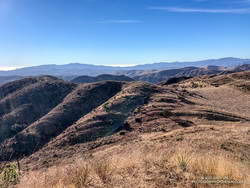
There is a survey marker on the high point labeled “N.A.A.V. INC. L.S. 2379 1953.” This is where the Upper Las Virgenes Canyon Open Space Preserve, SSFL and Runkle Ranch properties meet. According to 3DEP Lidar data, the elevation of the high point is about 2162′.
The side trip to the high point and back took about 20 minutes. After returning to the fire road, I continued down to the junction with Albertson Mtwy, turned left, and followed it west to a junction with an Edison powerline service road. This road meanders south through a rugged canyon, and then climbs up and over a prominent ridge with some spectacular sandstone rock formations.
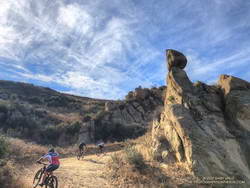
After topping out on the ridge, the service road descends to the junction of the Sheep Corral and Cheeseboro Ridge Trails. Today, I followed the Cheeseboro Ridge Trail south to the Las Virgenes – Cheeseboro connector. Once back in Upper Las Virgenes Canyon, I retraced my route from earlier in the day back to the Victory Trailhead.
Here is an interactive, Cesium 3D terrain view of most of the 20-mile route. The bushwhack to the Preserve high point and an exploration of the Norway Trail aren’t shown.
Some related posts: Upper Las Virgenes Canyon – Cheeseboro Ridge Loop, Upper Las Virgenes Canyon Backcountry, Trail Run and Hike to Peak 1842 at Ahmanson Ranch
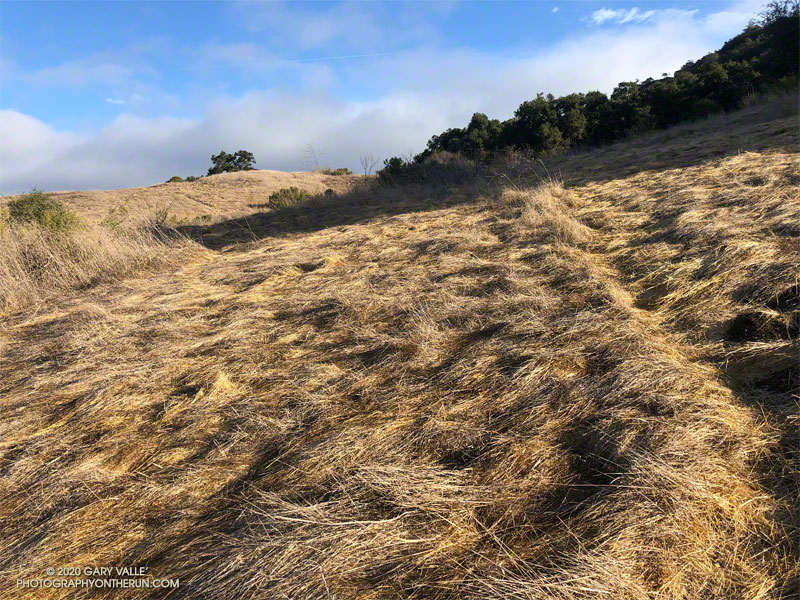
Taken on today’s trail run from the “Top of Reseda” to Trippet Ranch and back.
Here’s a Cesium 3D interactive view of a GPS track of my usual route. Today I did the Garapito and Musch Trails on the way out, then ran the fire roads on the way back.
Some related posts: The Heavenly Ranch in the Hills, Garapito Trail Runs
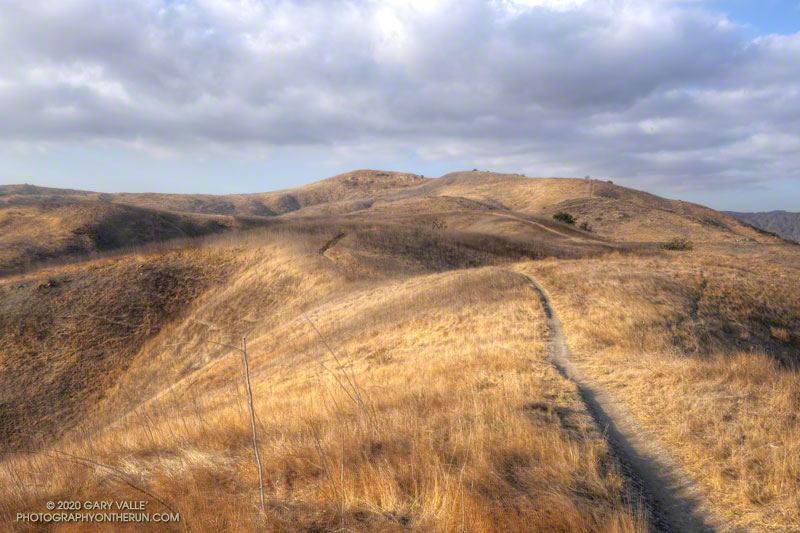
The hill marked with an elevation of 1842′ on the USGS 7.5 minute Calabasas quadrangle appears to be the highest point of the portion of the Ahmanson Ranch property that was going to be developed.
I usually start the 2+ mile trail run to the peak by ascending the Hill Climb Trail — a short, steep hill a little west of the kiosk at the Victory Trailhead. A less steep trail can be found a little farther to the west.
Once at the top of this initial 120′ high hill, I try to run — without walking — all the way to the ridgeline just west of the peak. Whether I walk or not, it’s a fun run with excellent views of the area.
From the ridgeline at the top of the single-track trail, there is usually some sort of a use trail to the top of the peak. The location and clarity of the path varies from year to year. The area can be very overgrown. It’s worth taking the time to find and stay on a use trail. Earlier this December, I encountered a rattlesnake while trying to follow an old route through the brush.
Here’s a Cesium interactive, 3D view of my route.
Note: The Ahmanson Ranch project property and Upper Las Virgenes Canyon Open Space were combined to create Upper Las Virgenes Canyon Open Space Preserve.

The photograph of Ladyface and the setting sun was taken from Lasky Mesa during an afternoon run in Upper Las Virgenes Canyon Open Space Preserve (Ahmanson Ranch).
Related post: Longer Late Afternoon Runs
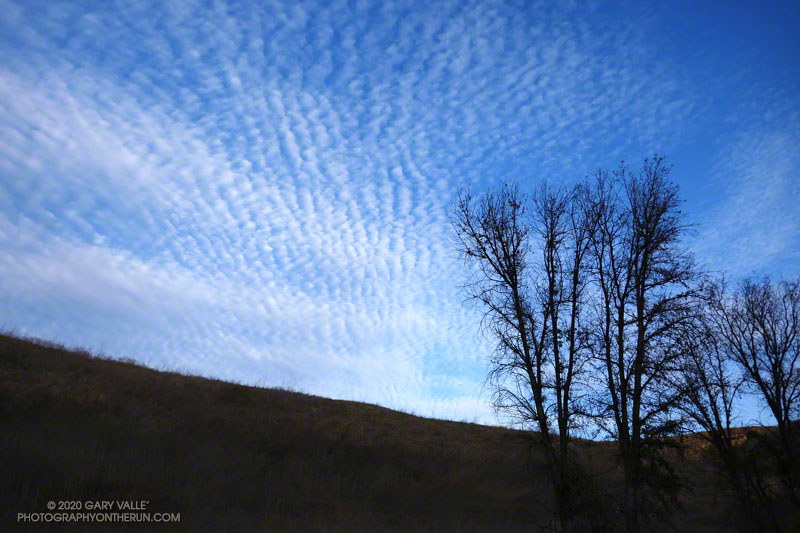
Cirrocumulus clouds form at high altitude. They are primarily composed of ice crystals but also contain supercooled water droplets.
The photograph of cirrocumulus clouds was taken in Las Virgenes Canyon on a trail run from the Victory Trailhead of Upper Las Virgenes Canyon Open Space Preserve, also known as Ahmanson Ranch.
Some related posts: Pattern Change Ahead, Fallstreak Hole, Rainbow Colors in Cirrus Clouds Over Los Angeles